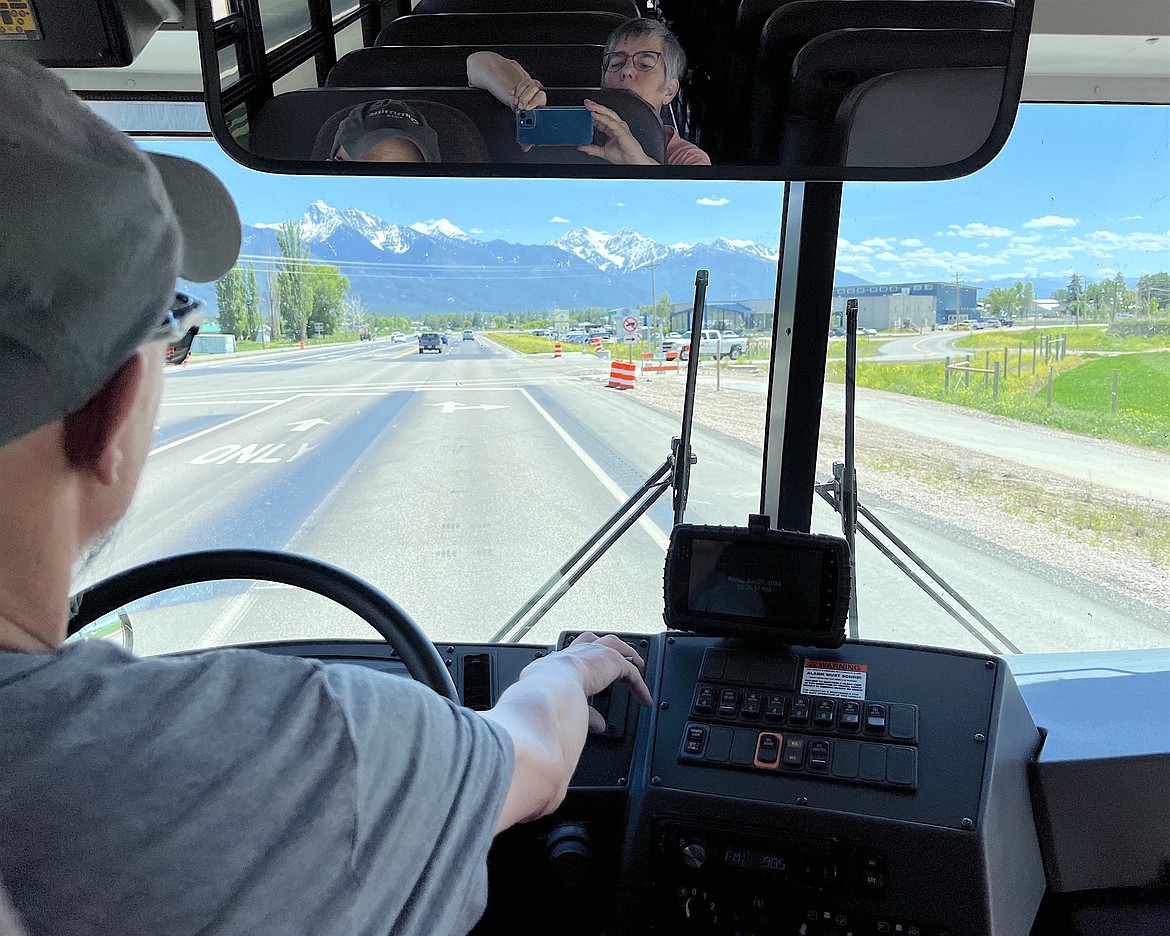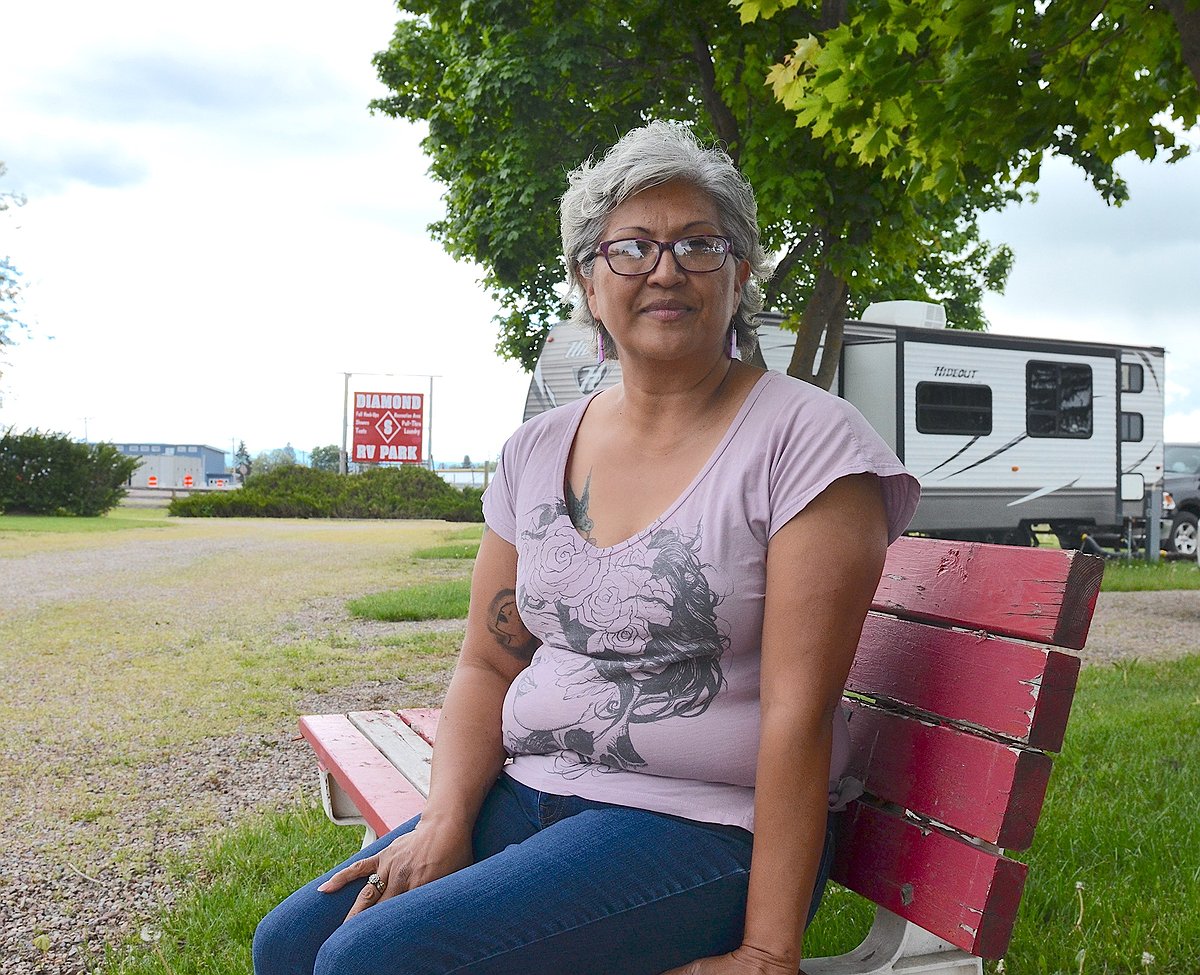Ronan intersection evokes public outcry
School buses are big and require ample space to execute a turn, especially when there’s a vehicle in the lane where the bus is turning.
That observation was made abundantly clear to this reporter when she took a ride last Friday with Matt Gaut, director of transportation for the Ronan School District.
Gaut was providing a firsthand look at the reconfigured intersection of Third Ave. N.W. and Highway 93 in Ronan, just north of the Boys and Girls Club. He had radioed ahead, so when we arrived at the intersection, a white pickup driven by a district employee was waiting – as though poised to turn onto the busy highway.
“For me to make this corner, this is the only way I can stay on the pavement,” Gaut says, estimating he was within six to 12 inches of the driver’s side door. Otherwise, the bus’s rear wheels “would go off into the ditch.”
“Wow! That’s awful,” squeaked the reporter as he made the turn.
“I figured I'd scare the crap out of you,” Gaut replied, noting that kindergartners he has delivered to K. William Harvey Elementary “have eyes as round as saucers” when they witness such a close call.
Of course, Gaut is a veteran bus driver with 11 years of experience. Plus, it’s a sunny summer afternoon. The pavement is dry, and the southbound traffic isn’t yet as congested as it will be in late August when school begins again.
If no one is waiting in that intersection, drivers pull into the other lane. But when a vehicle is waiting to turn onto 93 and a southbound bus is making a righthand turn, it’s “a very uncomfortable situation” for the drivers of both vehicles.
“I don't want an inexperienced bus driver making that corner,” Gaut says, adding that he has veteran drivers assigned to the Ronan-Pablo route, “but I'm not always going to have that luxury.”
He’s also concerned about winter driving conditions. “That is a scary intersection right now in the summertime. When we start throwing snow and ice into the mix, it’s a ticking time bomb.”
Plus, he notes that when a 40-foot-long bus is waiting to execute the right-hand turn, it effectively blocks visibility for the driver waiting to emerge onto the highway.
Overall, Ronan has more than 20 bus routes, and the eight buses that drive from Ronan to Pablo twice a day transport close to 400 kids. On their way to Pablo from the Ronan bus barn, they travel to the stoplight at Round Butte Road and hang a left; on their way back, they take a right on Third Avenue.
His advice to the Department of Transportation? Restore the righthand turn lanes that were previously there.
“I don’t build roads, but it would seem to me that anytime you can create a lane … to completely separate fast-moving traffic from slow-moving traffic, it would be a much safer avenue to go.”
Bike riders and RVs
On the opposite side of the intersection, Bonnie Asencio worries that the northbound turn from Hwy. 93 on to Old Highway 93 will cause trouble for her customers pulling off the highway and into Diamond S RV Park, many tugging big campers or driving RVs that are 30 to 50 feet long.
“So, this one's 39 I believe, this one's 42, this one's 50 feet – and they were pulling a car so they were about 60,” she says, pointing to three of the vehicles in the 37-space park.
Last summer, when road construction was at its peak, she advised northbound customers to drive past the turnoff, take the next right and swing back to the park as a temporary solution. “I didn't know they were going to leave it like that,” she said. “There's just no safe way to get in and out.”
She reports seeing one collision already at the intersection and predicts more to come.
She also worries about bicyclists and pedestrians, who must cross Hwy. 93 at the yet-to-be installed traffic light, and then cross Old Hwy. 93 to continue into Ronan via the walking path.
She’s says 150 bicyclists have reserved the park Sept. 22 for a bike rally, and frets about their safety while navigating the intersection. She also says the multi-use path was initially slated to pass under the highway via an underpass, which would have been a much safer remedy for cyclists and pedestrians.
Asencio echoes Gaut’s concern that access was actually better before construction of the new four-lane section because – even though there was a slight jog at the intersection – each side had its own right-hand turn lane.
“It was bigger than that when they started,” she says of the entrance to the old highway. “I don't understand why they made it smaller.”
Lorraine Lynch, whose family owns a fencing company that regularly pulls long trailers through the intersection, also voiced frustration. She says people rarely adhere to the posted speed limit of 45, especially on their way north, and that longer vehicles – the kind used by tourists, cattle ranchers, fence builders and potato farmers – can’t navigate the corner without veering into the lane of oncoming vehicles waiting to turn onto the highway, or encroaching on the area where pedestrians are waiting to safely cross one or both roadways.
She’s spoken to Riverside Construction workers who have been working on the project for more than a year, and was told they were following the design specs.
“I have got no complaint with Riverside. I think they're doing the best they can,” she said. “But, here's who's liable for this: the person who designed it.”
MDOT: The design works
Bob Vosen, who heads the MDOT’s Missoula division, which encompasses Lake County, told county commissioners during a regularly scheduled meeting last Monday that the new intersection may take some getting used to.
His engineers, he said, are confident that the design is adequate. “All the models – the guys told me that they've triple checked it, but they're triple checking it for the fourth time – show that it does work.”
Vosen says the design straightened out the intersection, and at the same time made the corners a 90-degree turn. “So you’ve got to slow down,” he said. “It's like making a corner around a city block.”
He said new paint stripes will give more room to vehicles turning right off Highway 93 by giving less to those entering the highway at the intersection. He estimated that the adjustment would expand the entry to 15 feet, while reducing the width of the exit lane to around 12 feet – all without adding an ounce of pavement. Workers also have removed the large barrels and cones that made the intersection “feel tight.”
“So once we get that out of the way and get that paint stripe in, it’ll help a little bit,” he said.
Vosen also believes the turn signal will improve matters. Although securing parts has been a problem – he was optimistic it could be online within a month.
“We know that drivers can do it and stay in their own lane,” he said. “It's just a matter of they have to be focused on doing it so the design works.”
Commissioner Bill Barron said he watched a truck pulling a trailer make the turn onto Third recently. “He slowed way down, pulled over as far to the center line as he could, and then he made his turn, and he didn't cross any lines,” Barron said.
He also acknowledged that bus drivers face a different challenge because their longer wheel base requires a wider turning radius.
The former sheriff believes habit plays a role too. “That intersection has been there for 60 years and there's a lot of people that have been taking that corner at 35 miles an hour for 60 years and now they've got to take it at 15.”
Want a bus ride?
Ronan Superintendent Mark Johnston wrote in an email that the project director had contacted him after he reached out to Vosen about the intersection. “I told him it was a horrible design and needed to be changed for the safety of our students.”
“I was told that I would be put into the loop as they discussed what could be done. I have yet to be updated,” he said.
Vosen told commissioners at last week’s meeting that the project manager planned to meet with the school transportation director, but as of press time, Haut said no one from the Department of Transportation had reached out to him for input.
“You can run all the graphs and schematics and pencil it out on paper and it might seem just fine,” he said. “But when you go and talk to the people that it actually affects, they're the ones that are going to tell you whether or not whatever you put down on paper or the computer spits out at you is gonna work.”
“A lot of this could have been solved if they would have just come and spoken to us first,” added Haut. “I can tell you that every single one of my bus drivers that uses that intersection, and one of them is a Ronan City cop, has very big concerns that it is a mess right now and it is an accident just waiting to happen.”
He’s skeptical that redrawing lines on the intersection will make it easier for his drivers to navigate that turn.
“When there is only so much available space, it doesn't matter how you use it. A 40-foot bus only fits in a certain amount of space, a certain way, and there is no way to learn how to navigate that corner, especially if there’s another vehicle parked there.”
To prove his point, he said he’d be happy to give MDOT officials the same ride he gave to this reporter.
According to the most recent press release from Sloane Simpson of Big Sky Public Relations, crews are continuing work on the new sidewalk along Round Butte Road, and installing streetlight poles along Highway 93.
“In response to community feedback, the Montana Department of Transportation is evaluating the newly realigned intersection of US 93 with Old US 93 and Third Avenue,” she writes. “An update will be provided soon. We appreciate everyone’s patience as we work to deliver a safe solution.”
Meanwhile, the public can email questions or concerns to sloane@bigskypublicrelations.com or call the project hotline at 406-207-4484, 9 a.m. to 5 p.m. Monday through Friday.



